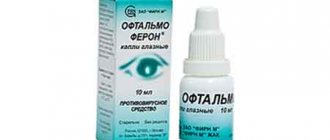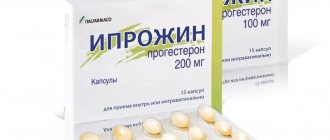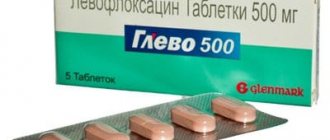Release form and composition
Bromazepam Lannacher is produced in the form of film-coated tablets: green, odorless, biconvex, round, with a break line (10 pieces in blisters, 2 blisters in a cardboard pack).
Composition of 1 tablet:
- active ingredient: bromazepam – 3 or 6 mg;
- additional components: sodium starch glycolate (type A), lactose monohydrate, magnesium stearate, microcrystalline cellulose;
- film shell: hypromellose 5 mPa*s, titanium dioxide (E171), macrogol 6000, polyacrylate dispersion 30%, talc, dyes patent blue V (E131) and green (yellowish) powder varnish (E104/132).
Pharmacological properties
Pharmacodynamics
Bromazepam is a tranquilizer (anxiolytic drug), a benzodiazepine derivative. By increasing the sensitivity of GABA (gamma-aminobutyric acid) receptors, the drug enhances its inhibitory effect on the CNS (central nervous system).
The drug reduces emotional stress, feelings of anxiety, fear, and anxiety. It has a slight anticonvulsant, sedative-hypnotic and central muscle relaxant effect.
Pharmacokinetics
Cmax in the blood (maximum concentration in plasma) is achieved 1–2 hours after administration. When administered orally, the bioavailability of bromazepam is 60%, binding to blood proteins is about 70%.
The half-life (T½) averages 20 hours, and may increase in elderly patients.
Bromazepam is metabolized in the liver. Only one of the two quantitatively predominant metabolites (3-hydroxybromazepam) exhibits pharmacological activity. It is excreted mainly in the form of conjugated metabolites in the urine.
Additional Information
According to the results of clinical trials, this drug enhances the effects of drugs that inhibit the activity of the central nervous system. You should not combine taking these tablets with antipsychotics, sedatives, antidepressants and other tranquilizers. Bromazepam and alcohol also do not mix well.
The drug enhances the effects of anesthetics, muscle relaxants, antihistamines, anticonvulsants and hypnotics, and increases the toxicity of drugs that contain zidovudine. Concomitant use with narcotic analgesics can lead to increased euphoria, which increases the likelihood of developing dependence.
Indications for use
- psychopathy and neuroses occurring with anxiety, phobias, emotional stress;
- dermatoses and headaches of psychogenic nature;
- fear and anxiety arising before surgical and endoscopic manipulations;
- insomnia caused by fear neuroses;
functional psychosomatic disorders: tachycardia, arterial hypertension of emotional origin, pseudoangina pectoris, difficulty breathing, shortness of breath, hyperventilation, irritable bowel syndrome, dysmenorrhea, menstrual and menopausal disorders, frequent urination.
Contraindications
Absolute:
- acute respiratory failure, asphyxia syndrome, severe chronic obstructive pulmonary disease (COPD), severe chronic hypercapnia;
- severe liver failure;
- shock, coma;
- severe depression (due to possible suicidal tendencies);
- acute poisoning with psychoactive substances, hypnotics, narcotic analgesics;
- drug or alcohol addiction;
- acute intoxication with other depressants, alcohol;
- myasthenia gravis;
- angle-closure glaucoma (predisposition or acute attack);
- age under 18 years;
- congenital galactose intolerance, Lapp lactase deficiency and glucose-galactose malabsorption syndrome (1 tablet contains 107 mg of lactose);
- pregnancy and lactation;
- hypersensitivity to any of the components of the drug (including benzodiazepines).
Relative (bromazepam should be used with caution):
- organic brain lesions;
- chronic renal failure;
- liver failure;
- cerebral and spinal ataxias;
- hyperkinesis;
- sleep apnea;
- hypoproteinemia;
- elderly age.
Directions for use and dosage
Bromazepam Lannacher is taken orally, at night, in a dose of 1.5–3 mg. The tablets should be taken with a small amount of liquid.
It is recommended to take the drug in the minimum effective dose, in the shortest possible course.
If necessary, it is allowed to increase the evening dose by 2 times, it is also possible to prescribe additional doses 1-2 times a day of 1.5-3 mg.
In a hospital setting, in severe cases, the drug can be recommended in a daily dose of 12–18 mg, divided into 3–4 doses. The duration of therapy should not exceed 8–12 weeks.
To reduce the daily dose, reduce the daily intake. Upon completion of a long course, the drug should be discontinued gradually, gradually reducing the dose, due to the possible development of withdrawal syndrome.
Reviews from doctors and patients
Many patients are faced with the need to take Bromazepam tablets. Instructions for use, indications, possible complications - this is, of course, important information. But for many people, reviews are also important.
Of course, the drug helps to cope with anxiety and depression, severe stress, and mental stress. Doctors confirm that significant improvements can be observed just a few days after the start of therapy. On the other hand, this is a serious drug that is addictive. Treatment should be stopped slowly, gradually reducing the dose. That is why you should never take such pills without permission. The disadvantages include the high cost of the medicine, although many analogues are more expensive.
Side effects
Often:
- severe sedation, dizziness and myasthenia gravis (mainly in weakened and elderly patients);
- drowsiness, fatigue, lethargy, decreased ability to concentrate, memory impairment, slowed motor and mental reactions;
- gait disturbance or confusion, ataxia.
Rarely:
- headache, weakness, tremor, dystonic extrapyramidal reactions, anterograde/retrograde amnesia, worsening of existing depression or its development, decreased emotionality and activity, apathy, depressed mood, euphoria, irritability, confusion;
- speech disorders, dysarthria, blurred/double vision;
- tachycardia, hypotension;
- anemia, leukopenia, thrombocytopenia, neutropenia, agranulocytosis (sore throat, chills, excessive fatigue/weakness, hyperthermia);
- functional kidney disorders, urinary incontinence/retention, dysmenorrhea, increased/decreased libido;
- salivation, loss of appetite, vomiting, diarrhea, constipation, nausea, dry mouth, difficulty swallowing, heartburn, functional liver disorders, jaundice, increased activity of alkaline phosphatase and hepatic transaminases, weight loss;
- itching, skin rash, exanthema, allergic reactions;
- drug dependence, addiction, withdrawal syndrome that occurs with a sharp reduction in dose or cessation of therapy (nausea, vomiting, increased sweating, dysphoria, nervousness, irritability, sleep disturbance, spasm of skeletal muscles and smooth muscles of internal organs, tremor, depersonalization, hallucinations, photophobia, hyperacusis, paresthesia, convulsions, tachycardia; rarely - acute psychosis).
It is extremely rare when taking the drug, especially in elderly patients, that paradoxical reactions may develop (irritability, acute agitation, aggressive outbursts, hallucinations, confusion, insomnia). If such disturbances occur, therapy should be discontinued.
Instructions:
Clinical and pharmacological group
02.008 (Tranquilizer (anxiolytic))
pharmachologic effect
Anxiolytic drug (tranquilizer), a benzodiazepine derivative. It has anxiolytic, sedative, hypnotic, anticonvulsant and central muscle relaxant effects.
The mechanism of action is associated with an increase in the inhibitory effect of GABA in the central nervous system due to an increase in the sensitivity of GABA receptors to the mediator as a result of stimulation of benzodiazepine receptors. Stimulates benzodiazepine receptors located in the allosteric center of postsynaptic GABA receptors of the ascending activating reticular formation of the brain stem and interneurons of the lateral horns of the spinal cord. Reduces the excitability of subcortical structures of the brain (limbic system, thalamus, hypothalamus), inhibits postsynaptic spinal reflexes.
The anxiolytic effect is due to the influence on the amygdala complex of the limbic system and manifests itself in a decrease in emotional stress, easing anxiety, fear, and restlessness.
The sedative effect is due to the influence on the reticular formation of the brain stem and nonspecific nuclei of the thalamus and is manifested by a decrease in neurotic symptoms (anxiety, fear).
Pronounced anxiolytic activity is combined with a moderate hypnotic effect; shortens the period of falling asleep, increases the duration of sleep, reduces the number of night awakenings. The mechanism of the hypnotic effect is the inhibition of the cells of the reticular formation of the brain stem. Reduces the impact of emotional, vegetative and motor stimuli that disrupt the mechanism of falling asleep.
Pharmacokinetics
After oral administration, it is quickly and almost completely absorbed from the gastrointestinal tract. Cmax in blood plasma is achieved after 0.5-4 hours and is maintained for 12 hours. Plasma protein binding is about 70%.
Subject to intense metabolism in the liver. The main route of metabolism in humans is hydroxylation at the 3rd position, followed by glucuronidation and cleavage of the heterocyclic ring, hydroxylation into the benzene ring and conjugation. Of the resulting metabolites, only 3-hydroxybromazepam has pharmacological activity and is excreted in the urine in the same quantities as unchanged bromazepam.
T1/2 from blood plasma is 20-32 hours.
Less than 2% is excreted unchanged in the urine. About 37% of unidentified metabolites with unknown activity are present in urine.
Dosage
In outpatient settings, use 1.5-3 mg 2-3 times a day, in hospital settings in severe cases - 6-12 mg 2-3 times a day. The duration of treatment is 2-4 weeks, then bromazepam is gradually discontinued or switched to maintenance therapy.
Maximum dose: 60 mg/day.
Drug interactions
When used simultaneously, bromazepam enhances the effect of drugs that have a depressant effect on the central nervous system, ethanol.
When used simultaneously with metoprolol, the AUC of bromazepam may increase and the effect of metoprolol on systolic blood pressure may increase.
When used simultaneously with fluvoxamine, the concentration of bromazepam in the blood plasma increases, which may be accompanied by impaired cognitive function. It is believed that this interaction is due to inhibition of the metabolism of bromazepam under the influence of fluvoxamine.
Use during pregnancy and lactation
Bromazepam has a toxic effect on the fetus and increases the risk of birth defects when used in the first trimester of pregnancy. Use in the second and third trimesters of pregnancy is possible only for health reasons. Use during pregnancy may cause a slowdown in fetal heart rate.
Chronic use during pregnancy can lead to physical dependence with the development of withdrawal syndrome in the newborn. Taken in therapeutic doses in later stages of pregnancy may cause depression of the central nervous system of the newborn. Use immediately before or during labor may cause respiratory depression in the newborn, decreased muscle tone, hypotension, hypothermia, and weak sucking (“floppy baby” syndrome).
Side effects
From the side of the central nervous system and peripheral nervous system: at the beginning of treatment (especially in elderly patients) - drowsiness, fatigue, dizziness, decreased ability to concentrate, ataxia, lethargy, dullness of emotions, slowed mental and motor reactions; rarely - headache, depression, tremor, memory loss, anterograde amnesia, depressed mood, confusion, dystonic extrapyramidal reactions (uncontrolled body movements, including the eyes), weakness, myasthenia gravis, dysarthria, diplopia; in some cases - paradoxical reactions (aggressive outbursts, hallucinations, acute agitation, irritability, anxiety, insomnia).
From the hematopoietic system: leukopenia, neutropenia, agranulocytosis (chills, hyperthermia, sore throat, unusual weakness), anemia, thrombocytopenia.
From the digestive system: dry mouth or drooling, heartburn, nausea, vomiting, loss of appetite, constipation or diarrhea; liver dysfunction, increased activity of liver transaminases and alkaline phosphatase, jaundice.
From the urinary system: possible urinary incontinence, urinary retention, impaired renal function.
From the reproductive system: decreased libido, dysmenorrhea are possible.
Allergic reactions: rarely - skin rash, itching.
From the cardiovascular system: rarely - arterial hypotension, tachycardia, palpitation.
Other: rarely - weight loss.
Indications
Neuroses and psychopathy (accompanied by phobias, anxiety, emotional stress, restlessness), insomnia (with fear neuroses).
Functional psychosomatic disorders of the cardiovascular system (pseudoangina, vasospastic angina, cardialgia, cardiophobia, arterial hypertension of emotional origin); respiratory system (hyperventilation, difficulty breathing, shortness of breath); digestive system (irritable bowel syndrome); urinary and reproductive systems (frequent urination, dysmenorrhea, menopausal and menstrual disorders). Psychogenic headache. Psychogenic dermatoses (diseases accompanied by itching, irritability).
Contraindications
Coma, shock, acute alcohol intoxication with weakening of vital functions, acute poisoning with opioid analgesics, hypnotics and psychotropic drugs, myasthenia gravis, angle-closure glaucoma (acute attack or predisposition), severe COPD (progressive degree of respiratory failure), acute respiratory failure, severe depression ( Suicidal attempts may occur), pregnancy (especially the first trimester), lactation, childhood and adolescence under 18 years of age (safety and effectiveness have not been determined), hypersensitivity to benzodiazepines.
special instructions
Use with caution in case of cerebral and spinal ataxia, liver failure, chronic renal failure, hyperkinesis, history of drug dependence, tendency to abuse psychotropic drugs, organic diseases of the brain, psychosis (paradoxical reactions are possible), hypoproteinemia, sleep apnea (established or suspected) in elderly patients.
In patients with epilepsy, the use of bromazepam may lead to an increase in the frequency and/or severity of seizures. In such cases, it is recommended to adjust the dosage regimen of anticonvulsants. It should be kept in mind that abrupt discontinuation of benzodiazepines in patients with seizure disorders may be associated with a temporary increase in the frequency and/or severity of seizures. When using bromazepam simultaneously with an anticonvulsant, the concentration of the latter in the blood plasma should be monitored.
Use with caution in patients who abuse medications. In such cases, it is recommended to limit repeated use of bromazepam without medical supervision.
Use benzodiazepines with caution in patients with impaired liver and/or kidney function.
With long-term use, systematic monitoring of peripheral blood patterns and liver function is necessary.
When bromazepam is used in recommended doses under medical supervision, tolerance rarely develops.
With a rapid reduction in dose or abrupt withdrawal of bromazepam, withdrawal syndrome may develop (headache, myalgia, anxiety, tension, confusion, irritability; in severe cases - derealization, hyperacusis, paresthesia in the extremities, light and tactile hypersensitivity, hallucinations and epileptic seizures). Withdrawal syndrome is more common with long-term use of bromazepam in high doses. Bromazepam should be withdrawn gradually.
Treatment should be stopped if such unusual reactions occur as increased aggressiveness, acute states of agitation, feelings of fear, thoughts of suicide, hallucinations, increased muscle cramps, difficulty falling asleep, shallow sleep.
During the treatment period, avoid drinking alcohol.
Impact on the ability to drive vehicles and operate machinery
During the treatment period, you should refrain from engaging in potentially hazardous activities that require increased attention and speed of psychomotor reactions.
Overdose
Symptoms of overdose include: in moderate cases - decreased reflexes, drowsiness, paradoxical arousal, confusion, nystagmus, ataxia, lethargy, shortness of breath, bradycardia, tremor; in severe cases (including when combined with other depressants) - muscle relaxation, hypotension, ataxia, respiratory depression, coma and death (extremely rare).
Treatment: while maintaining consciousness for 1 hour after administration, induce vomiting; in unconscious patients, the stomach is washed, taking measures to protect the respiratory tract. If gastric lavage is not practical, activated charcoal is prescribed. Measures are taken to restore respiratory and cardiac function. In hospital settings, flumazenil is prescribed as a specific antidote. Hemodialysis is ineffective.
special instructions
Bromazepam Lannacher is not indicated as a first-line treatment for depression or anxiety in depressive syndrome.
With long-term therapy, it is necessary to monitor the activity of liver enzymes and the picture of peripheral blood.
The likelihood of developing withdrawal syndrome increases in the case of high doses, abrupt discontinuation of therapy, or the use of bromazepam as a sedative during the day in combination with hypnotics (cross-tolerance).
Taking benzodiazepines can cause physical and mental dependence. The threat of this complication increases if there is a tendency to abuse alcohol or drugs, as well as during a long course in large doses.
During the period of use of bromazepam, the consumption of ethanol-containing drinks is unacceptable (mutual potentiation of the undesirable effects of both drugs is noted).
Impact on the ability to drive vehicles and complex mechanisms
During treatment, extreme caution is required when driving vehicles and operating other mechanisms due to a possible slowdown in motor/mental reactions and impaired concentration.
How much does the drug cost?
In modern medical practice, the drug Bromazepam is often used. Instructions for use, indications, contraindications - this is important information. But patients, of course, are also interested in the cost of the drug.
In fact, a lot will depend on the place of purchase, the pricing policy of the pharmacy, the manufacturer, distributor and some other factors. In most cases, you will have to pay about 3,000 rubles for a package of 50 tablets. Of course, this is a very high price, but many analogs are much more expensive.
Drug interactions
- anticonvulsants and sedatives, tranquilizers, neuroleptics, antidepressants, narcotic analgesics, sleeping pills, antihistamines, muscle relaxants, anesthetics, alcohol - the effect of these drugs is enhanced;
- levodopa – its effect is weakened;
- zidovudine - its toxicity is aggravated;
- antihypertensive drugs – increase the hypotensive effect of bromazepam;
- inducers of microsomal liver enzymes - the effectiveness of bromazepam is reduced;
- inhibitors of microsomal oxidation - the likelihood of toxic effects of bromazepam increases (due to prolongation of T½);
- cisapride – the effect of bromazepam is enhanced (due to an increase in the rate of absorption).
Medicine "Bromazepam": analogues and substitutes
This medicine is not suitable for everyone and not in all cases. Fortunately, today there are many medications that provide a sedative effect. What kind of medicines are these? Kalmepam and Bromidem have approximately the same properties. The list of effective substitutes includes the drugs “Normoc”, “Lexotan” and “Lexilium”. Of course, only a specialist can select such powerful tranquilizers. Bromazepam is not sold without a doctor's prescription (as well as other drugs in this group).











